Autumn in Silicon Valley .. the end of American exceptionalism?
Oct 31st, 2011 | By L. Frank Bunting | Category: USA Today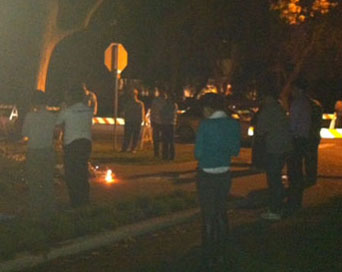 [UPDATED MARCH 17, 2012] : At first I wasn’t sure just what to make of our autumn 2011 holiday trip to Silicon Valley, in the (despite everything else) still aptly named Golden State of the USA today.
[UPDATED MARCH 17, 2012] : At first I wasn’t sure just what to make of our autumn 2011 holiday trip to Silicon Valley, in the (despite everything else) still aptly named Golden State of the USA today.
Then I bumped into two recent articles in the online edition of Foreign Policy magazine: “The Myth of American Exceptionalism … The idea that the United States is uniquely virtuous may be comforting to Americans. Too bad it’s not true,” by Stephen M. Walt ; and “Napoleon’s Curse … The illusion of omnipotence has exhausted America and spoiled its allies, “ by Ian Buruma.
 And then, on our first full day back in the true north I bumped into another four items on the world wide web: “Apple retail stores close as employees gather for tribute to Steve Jobs at Apple headquarters” ; “Apple staff mourn as Steve Jobs honored” ; “Steve Jobs and the Seven Rules of Success” ; and then “Apple results fall short, shares hammered.”
And then, on our first full day back in the true north I bumped into another four items on the world wide web: “Apple retail stores close as employees gather for tribute to Steve Jobs at Apple headquarters” ; “Apple staff mourn as Steve Jobs honored” ; “Steve Jobs and the Seven Rules of Success” ; and then “Apple results fall short, shares hammered.”
At this point I thought I had my story. Our holiday was headquartered in the City of Palo Alto – “intellectual centre” of the contemporary economic geography of the information technology revolution, which may remain the boldest survival of the old-time American Dream (albeit in a suitably revised and updated variation on the theme).
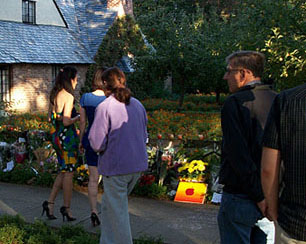 As just the leading case in point, our first stop just after we arrived was the “British country style” house of Steve Jobs, at “2101 Waverley St., Palo Alto, CA 94301.” It was three days since the visionary microelectronic guru’s death from pancreatic cancer, at the all-too-early age of 56. But there were still spontaneous mourners paying homage outside his house – more, it would seem from some photographs, than on the evening of his death.
As just the leading case in point, our first stop just after we arrived was the “British country style” house of Steve Jobs, at “2101 Waverley St., Palo Alto, CA 94301.” It was three days since the visionary microelectronic guru’s death from pancreatic cancer, at the all-too-early age of 56. But there were still spontaneous mourners paying homage outside his house – more, it would seem from some photographs, than on the evening of his death.
Some were surprisingly well-dressed. Among them two beautiful young East Asian women were taking pictures. As I look back now they seem to summarize what we learned from our trip. (Or what I feel I learned at any rate: as usual, my traveling companion may not entirely agree. Oh, and for immediate access to my March 17, 2012 update on Mike Daisey and his The Agony and the Ecstasy of Steve Jobs, scroll down immediately to the bottom of this page! )
1. The Big Valley we saw on our holiday
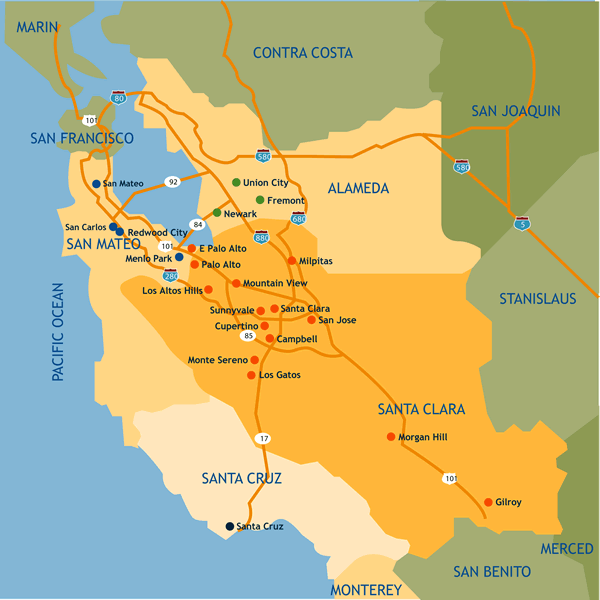 On a conventional narrow view “Silicon Valley” is “a region in California centered in Santa Clara County, including the cities of San Jose, Palo Alto, Sunnyvale, Cupertino, Los Gatos, and Menlo Park.. The valley was named from the mass production of electronic products made from silicon-based semiconductors …”
On a conventional narrow view “Silicon Valley” is “a region in California centered in Santa Clara County, including the cities of San Jose, Palo Alto, Sunnyvale, Cupertino, Los Gatos, and Menlo Park.. The valley was named from the mass production of electronic products made from silicon-based semiconductors …”
More broadly (and physiographically) : “It is roughly bounded by San Francisco Bay on the north, the Santa Cruz Mountains on the west, and the Diablo Range on the east.”
On such a wider view, you might say, the Valley includes, at its most northern extremity, the romantic City of San Francisco itself, and the fabled liberal shores of Marin County across the Golden Gate Bridge. At the opposite southern extreme it also takes in the exotic miniature ocean-side cities of Monterey, Pacific Grove, and Carmel (or more exactly Carmel-By-the-Sea) – sometime weekend retreats for high-tech Valley workers, south of San Jose.
This wider geographic view at any rate defined our own holiday terrain. It may be slightly eccentric, or worse. But who would deny that to visit Silicon Valley without spending some time in San Francisco would be a vast mistake? (And while you’re at it, why not see Carmel too?)
2. I Left My Heart (and My Wallet?) in San Francisco
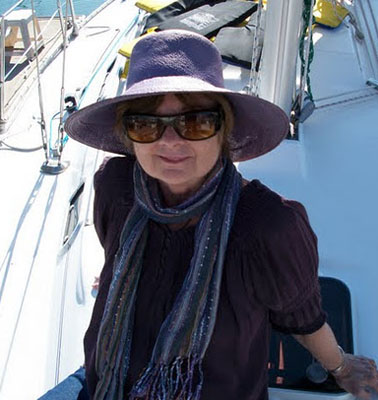 After the giant road-rage and mass entertainment capital in Los Angeles, San Francisco is certainly the second most important city in the Golden State.
After the giant road-rage and mass entertainment capital in Los Angeles, San Francisco is certainly the second most important city in the Golden State.
Yet with strict regard to the local governments recognized by the State of California, it is only the state’s fourth most populous city. San Francisco proper had 813,000 people in round numbers at the start of 2011. (As just one initial nuance, some will also want to include the separate City of Oakland on the mainland due east, which adds an additional 393,000 people right away – and, most recently, a troubled encounter with the local expression of the Occupy Wall Street movement.)
On our first visit to San Francisco proper this fall we parked around new upscale condo developments on old industrial land south of Market Street. Then we walked along the Embarcadero all the way to Fisherman’s Wharf. Later we walked at least halfway back to our parking spaces, through Washington Square, before some in the party began desperately seeking taxis. From all this I can report that on the streets of San Francisco, autumn 2011 edition, it is not altogether easy to see the much-discussed current economic crisis in the United States of America (or the State of California) writ large.
In fact, judging from the continuing high prices of local real estate alone, it might seem that only those with seriously high incomes can afford to live in San Francisco today. (The average listing price for a house in the city at the moment is more than $1 million.)Â The crowd at a cheesesteak and hot dog stand on a gentle hill in North Beach, where we stopped briefly to eat, nonetheless suggested that some in more modest economic circumstances are somehow managing to survive.
3. On San Francisco Bay
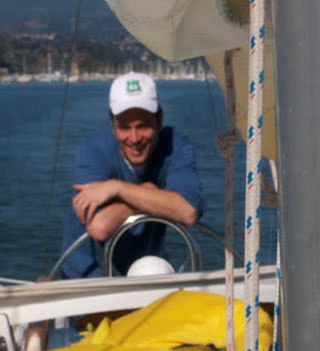 Geographically, the City of San Francisco occupies the most northern reach of a long peninsula, with the Pacific Ocean on the west and San Francisco Bay on the east – and north. The Bay Bridge (currently being renovated with modular parts from China) goes east across the bay to Oakland and Berkeley and points beyond, on the mainland.
Geographically, the City of San Francisco occupies the most northern reach of a long peninsula, with the Pacific Ocean on the west and San Francisco Bay on the east – and north. The Bay Bridge (currently being renovated with modular parts from China) goes east across the bay to Oakland and Berkeley and points beyond, on the mainland.
The more dramatic Golden Gate Bridge goes north across the bay to Marin County and the Sonoma and Napa Valley wine country. It will also take you to the enchanted waterfront City of Sausalito, which boasts facilities for pleasure boats of all descriptions.
One highlight of our autumn 2011 holiday trip involved chartering a large sailboat. Then we spent a warm sunny day, with at least intermittently enough wind, sailing on San Francisco Bay – between the Bay and Golden Gate bridges.
Here as elsewhere, the most profound blessings of Northern California are its alluring natural geography and benign climate. In this case geography and climate are enhanced by the unique romanticism of the old “Victorian” housing stock in the unambiguously most beautiful (if also very hilly) city of America. Looking at it all, out on San Francisco Bay on a sunny day, you do find yourself thinking that there cannot be many more attractive places for sailing in the entire early 21st century global village. In this respect at least, American exceptionalism lives on.
4. San Mateo County and East Palo Alto
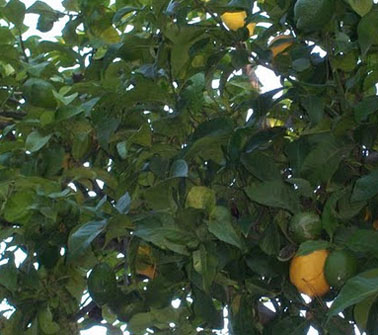 San Francisco is both a city and a county in its own right. Due south is San Mateo County. Much of it, especially toward the mountainous west, is so-called “unincorporated” territory – where residents receive municipal services directly from the county government.
San Francisco is both a city and a county in its own right. Due south is San Mateo County. Much of it, especially toward the mountainous west, is so-called “unincorporated” territory – where residents receive municipal services directly from the county government.
At the same time, one thing I took away from our autumn 2011 holiday trip to Silicon Valley is a new very strong sense of the more or less continuous easterly strip of urban development, that stretches southward from the southern border of San Francisco all the way down to San Jose.
Daly City is the first of the incorporated urban places in this strip. Many would likely enough say that its immediate successors as you move further south (South San Francisco, San Bruno, and Hillsborough, eg) are not really part of Silicon Valley proper, or some such thing.
Yet by the time you reach such southeastern San Mateo County places as Redwood City, Atherton, Menlo Park, and Woodside (a still forested place of stupendous affluence), even the narrowest case for inclusion has become indisputable.
The Valley’s “intellectual centre” of Palo Alto is in the most northerly part of Santa Clara County, right next to San Mateo County. An intriguing poor relation known as East Palo Alto, however, is still in San Mateo County. And some broad distinction between the two places underlines cultural, economic, and social cleavages that haunt contemporary California.
In a somewhat earlier era a very simplistic summary might just say that Palo Alto is rich and white, and East Palo Alto is black and poor – somewhat like St. Louis and East St. Louis back east on the Mississippi River, in another earlier era. But nowadays Palo Alto is not just white, and East Palo Alto is not just black.
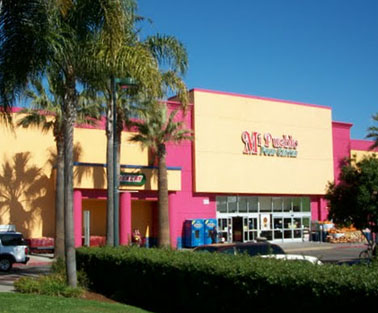 Thus another highlight of our holiday – my travelling companion will especially urge – was a visit to the Mi Pueblo supermarket in the new Ravenswood 101 shopping centre in East Palo Alto. Here as elsewhere in the state today there are strong Mexican undercurrents. Announcements in the supermarket are broadcast in Spanish. Mariachi bands feature prominently in the piped music that guides you up and down the aisles.
Thus another highlight of our holiday – my travelling companion will especially urge – was a visit to the Mi Pueblo supermarket in the new Ravenswood 101 shopping centre in East Palo Alto. Here as elsewhere in the state today there are strong Mexican undercurrents. Announcements in the supermarket are broadcast in Spanish. Mariachi bands feature prominently in the piped music that guides you up and down the aisles.
If you are indulging in the eccentric local sport of walking, on your way back to Palo Alto from Mi Pueblo you pass an immaculately maintained modern church property, bearing the sign “Asamblea Apostolica De La Fe En Cristo Jesus.” And then you see another sign: “East Palo Alto Sanitary District … Vote por Bethzabe (Betsy) Yanez para Directora del EPASD.”
5. Santa Clara County : Palo Alto and Stanford
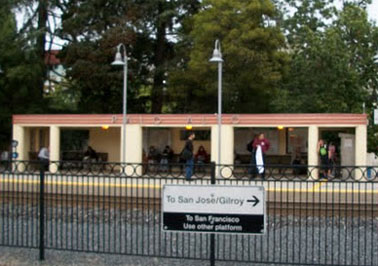 The City of Palo Alto today – immediately southeast of San Mateo County in the more pristine Silicon Valley heartland of Santa Clara County – is no longer quite as white as it used to be. For one thing, East and South Asians, eg, play a big role in the high-end information technology business that dominates the local scene. Yet, if anything, this city of 65,000 people is richer than ever. The average listing price of a house here at the moment is more than $2 million.
The City of Palo Alto today – immediately southeast of San Mateo County in the more pristine Silicon Valley heartland of Santa Clara County – is no longer quite as white as it used to be. For one thing, East and South Asians, eg, play a big role in the high-end information technology business that dominates the local scene. Yet, if anything, this city of 65,000 people is richer than ever. The average listing price of a house here at the moment is more than $2 million.
It is said that Palo Alto has twice as many jobs as people. And this no doubt helps account for the sweet smell of continuing economic prosperity that seems to follow you everywhere on the city streets, even in the autumn of 2011. At least if you have acquired the right stuff to meet the needs of the high-end branches of the information technology revolution, you don’t have to worry too much about unemployment in Palo Alto.
In the latest issue of the New York Review of Books Stanley Hoffmann, in a piece on the new Friedman and Mandelbaum book, That Used to Be Us: How America Fell Behind in the World It Invented and How We Can Come Back, alludes to “the information technology revolution, which ‘has changed the composition of work,’ eliminated old jobs, made almost all work more complex, and ‘requires every American to be better educated than ever to secure and keep a well-paying job.’”
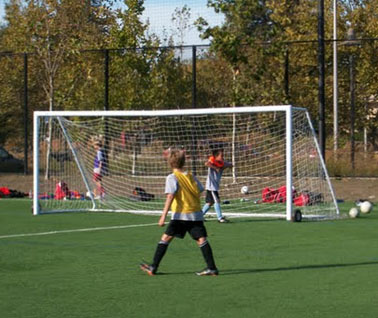 Silicon Valley in Northern California, for at least a while longer in the autumn of 2011, it would seem, remains the guiding headquarters of this revolution, not just in the USA but (still) in the new global village. (And, again, the Chinese and Indian couples stalking the halls of the giant new IKEA store in East Palo Alto underline the continuing global reach of the local area.)
Silicon Valley in Northern California, for at least a while longer in the autumn of 2011, it would seem, remains the guiding headquarters of this revolution, not just in the USA but (still) in the new global village. (And, again, the Chinese and Indian couples stalking the halls of the giant new IKEA store in East Palo Alto underline the continuing global reach of the local area.)
Palo Alto’s status as the “intellectual center” of Silicon Valley has everything to do with Stanford University. The city’s main street is called University Avenue. And if you follow it from its eastern origins all the way west, you will finally wind up at the imposing gates to Stanford, beyond which lies the majestic Palm Drive, royal road to the groves of academe within.
Many private sector/free market success stories of Silicon Valley had their start in the Stanford research community. (“In 1939, with the encouragement of their professor and mentor, Frederick Terman, Stanford alumni David Packard and William Hewlett established a little electronics company in a Palo Alto garage. That garage would later be dubbed ‘the Birthplace of Silicon Valley.’ Over the following years, Stanford would be a wellspring of innovation …”)
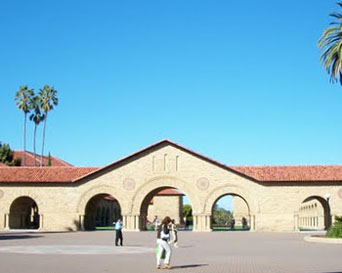 New fabulously wealthy almuni have not forgotten their alma mater. Here as elsewhere, the place oozes affluence, even now. A walk around just a few parts of the sprawling campus on a sunny autumn day can seem something like a walk around an ancient philosopher’s updated paradise – in the New World “Mediterranean climate” of Northern California. And there is also an upscale Stanford Shopping Center and Stanford Industrial Park
New fabulously wealthy almuni have not forgotten their alma mater. Here as elsewhere, the place oozes affluence, even now. A walk around just a few parts of the sprawling campus on a sunny autumn day can seem something like a walk around an ancient philosopher’s updated paradise – in the New World “Mediterranean climate” of Northern California. And there is also an upscale Stanford Shopping Center and Stanford Industrial Park
Some will tell you that Palo Alto’s status as a Silicon Valley intellectual centre has sparked the growth of an important venture capital regional financial centre as well. Strictly speaking, this is only half true. Most of the legendary local Sand Hill Road , “notable for its concentration of venture capital companies” whose “significance as a symbol of private equity in the United States may be compared to that of Wall Street in the stock market,” actually lies in adjacent Menlo Park – across the San Francisquito Creek, in San Mateo County.
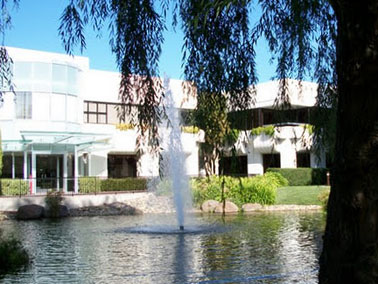 It is true enough, however, that Palo Alto proper in Santa Clara County does have a significant venture capital sector within its own narrow boundaries. A very partial list includes: Accel Partners, Alloy Ventures, Asset Management Company, Athena Technology Ventures, BIOASIA Investments, Charter Venture Capital, Com Ventures, Communications Ventures, Early Bird, Garage.com Investments, Infinity Capital Venture Fund, Information Technology Ventures LP, JAFCO America Ventures Inc., KTB Network, Lucent Venture Partners, Marcus & Millichap Venture Partners, and on and on and on, etc.
It is true enough, however, that Palo Alto proper in Santa Clara County does have a significant venture capital sector within its own narrow boundaries. A very partial list includes: Accel Partners, Alloy Ventures, Asset Management Company, Athena Technology Ventures, BIOASIA Investments, Charter Venture Capital, Com Ventures, Communications Ventures, Early Bird, Garage.com Investments, Infinity Capital Venture Fund, Information Technology Ventures LP, JAFCO America Ventures Inc., KTB Network, Lucent Venture Partners, Marcus & Millichap Venture Partners, and on and on and on, etc.
(Oh … and early in 1999 it was announced that: “The New York Stock Exchange has chosen Palo Alto as the site of its first major office outside New York … The world’s largest stock exchange has signed a 10,000-square-foot lease at 845 Page Mill Road.” In this as in other respects times have changed, no doubt. But I can testify first hand that there is still a New York Stock Exchange Building at 845 Page Mill Road – just east of a soothing fountain in the Stanford Industrial Park, and west of the Silicon Valley Bank in Palo Alto Square.)
6. Santa Clara County : From Mountain View to San Jose
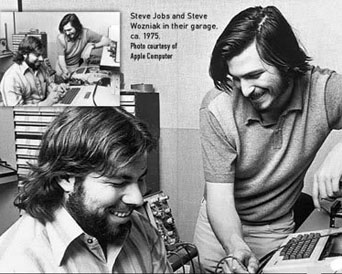 Steve Jobs was, among other things, “a hero of the counterculture” and a “60s’ Counterculture Inspired Visionary.” And at least something of the cultural revolutionary ideals of the 1960s survives in the high-end information technology business that dominates the Silicon Valley heartland today.
Steve Jobs was, among other things, “a hero of the counterculture” and a “60s’ Counterculture Inspired Visionary.” And at least something of the cultural revolutionary ideals of the 1960s survives in the high-end information technology business that dominates the Silicon Valley heartland today.
This is the American dream, but in a particular Northern California incarnation, as in: “If you’re going to San Francisco / Be sure to wear some flowers in your hair.”
Take, eg, the massive Google “campus” in Mountain View, due south of Palo Alto in Santa Clara County. We drove by on a Sunday morning, when only a few people were around, and just quickly took in the outdoor atmosphere of a few main buildings. But this was enough to put a message across. It was similar to the message we picked up in an article from the October 17, 2011 edition of the Inc. website, by the “writer and reporter” Christine Lagorio, and headlined “Which Has the Cooler Office, AOL or Facebook?”
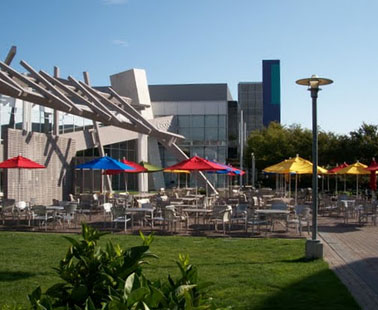 As explained by those who work in the cool offices of Silicon Valley, the point is to create a workplace ambience that promotes individual creativity and innovation. There are the cubicles where you have your desk and all the electronic equipment it may require. But there are also public places where you can play ping pong or pool, have a snack or a drink (even an alcoholic beverage, sometimes, it seems), discuss problems with colleagues, and draw on vast whiteboards. There are even small darkened rooms where you can go for a nap.
As explained by those who work in the cool offices of Silicon Valley, the point is to create a workplace ambience that promotes individual creativity and innovation. There are the cubicles where you have your desk and all the electronic equipment it may require. But there are also public places where you can play ping pong or pool, have a snack or a drink (even an alcoholic beverage, sometimes, it seems), discuss problems with colleagues, and draw on vast whiteboards. There are even small darkened rooms where you can go for a nap.
The employees in the cool offices still work long and hard. The workplaces are aggressively competitive. And you don’t have any easygoing job security. From the Dotcom Crash a decade ago down to the present, Silicon Valley has had its own economic ups and downs. There are said to be floors of start-ups in some cool office buildings, where very creative and innovative hi-tech gamblers are working long hours for minimal wages – hoping for gigantic returns on their investments (maybe), just a little further down the road.
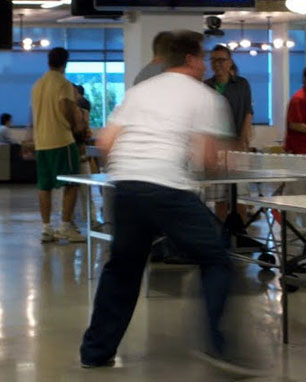 Virtually all the big enterprises in the Valley have been through waves of bloodletting layoffs over the past decade – as well as countervailing waves of mass hiring. Still … this is something quite different, they say, from Dagwood and Mr. Dithers back on the east coast. Steve Jobs himself was, everyone seems to agree, “a tyrant.” But in the giant Garage in the Valley that made him, American capitalism met the 60s’ Counterculture. Somehow both have survived.
Virtually all the big enterprises in the Valley have been through waves of bloodletting layoffs over the past decade – as well as countervailing waves of mass hiring. Still … this is something quite different, they say, from Dagwood and Mr. Dithers back on the east coast. Steve Jobs himself was, everyone seems to agree, “a tyrant.” But in the giant Garage in the Valley that made him, American capitalism met the 60s’ Counterculture. Somehow both have survived.
For better or worse, we bumped into the Mountain View Google campus (that it is called a campus no doubt says something about the greater weight of academia in this version of the corporate free market too), on our way down to the Deep South recreation centres of Monterey, Pacific Grove, and Carmel-By-The-Sea, driving on “the 101” multilane highway. We finally did not have time for further local investigations. More detailed encounters with the likes of Cupertino, Los Altos, Los Gatos, and Sunnyvale will have to wait for another trip.
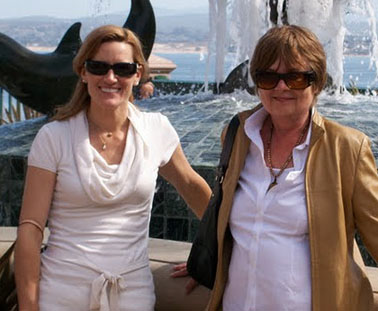 The same is true for the contemporary third-largest Californian city of San Jose. We drove by it (in two directions) – and even got stuck on its outskirts, in an extended episode of gruelling 101 gridlock, on our way back from the Deep South to our base camp in Palo Alto (well East Palo Alto actually, though right next to the Palo Alto border).
The same is true for the contemporary third-largest Californian city of San Jose. We drove by it (in two directions) – and even got stuck on its outskirts, in an extended episode of gruelling 101 gridlock, on our way back from the Deep South to our base camp in Palo Alto (well East Palo Alto actually, though right next to the Palo Alto border).
As old as I am, I still remember the Burt Bachrach tune that was a smash hit for Dionne Warwick in 1968, “Do You Know the Way to San Jose” – with lyrics by Hal David: “You can really breathe in San Jose / They’ve got a lot of space. There’ll be a place where I can stay / I was born and raised in San Jose / I’m going back to find some peace of mind in San Jose.”
Whatever else, in a number of respects in the autumn of 2011 (it seems clear enough even just driving by), things have changed in San Jose since Hal David wrote those lyrics.
7. John Steinbeck and Magical Monterey County in the Deep South
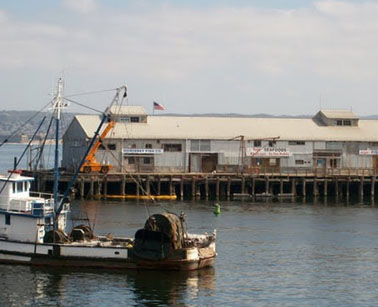 Santa Cruz County is due west of Santa Clara County – between the Santa Cruz Mountains and the Pacific Ocean. And the City of Santa Cruz, right on the coast, is an enchanted place in its own right. (Which we also visited on an earlier trip to the Golden State.) Due south of Santa Cruz County, however, is magical Monterey County. And our visit there marked the denouement of our autumn 2011 holiday trip to Silicon Valley.
Santa Cruz County is due west of Santa Clara County – between the Santa Cruz Mountains and the Pacific Ocean. And the City of Santa Cruz, right on the coast, is an enchanted place in its own right. (Which we also visited on an earlier trip to the Golden State.) Due south of Santa Cruz County, however, is magical Monterey County. And our visit there marked the denouement of our autumn 2011 holiday trip to Silicon Valley.
I wanted to go to Monterey County because of its ancient associations with the writing of John Steinbeck – who was born in the City of Salinas, the county’s largest municipality, some distance inland from the Pacific coast. But most other members of our party saw the main object of the Deep South denouement as Carmel-By-The-Sea, where the great Hollywood movie actor and director, Clint Eastwood, was once mayor (1986—1988).
We did not have time to visit the Steinbeck birthplace in Salinas on this trip. (I at least would still like to do this on another trip.) But the coastal City of Monterey – on the way to Carmel, as it happens – plays a key role in some of Steinbeck’s best-known writing. And Steinbeck himself lived in the coastal City of Pacific Grove just next to the City of Monterey, during a crucial stage in his early literary career.
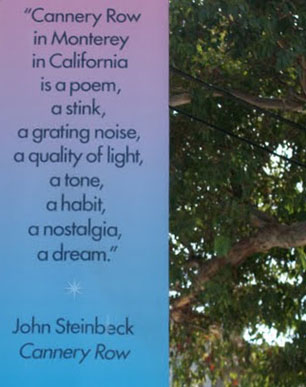 Earlier incarnations of the present-day City of Monterey and environs formed the setting for two landmark novels by John Steinbeck – Tortilla Flat (1935, and “the author’s first clear critical and commercial success”), and Cannery Row (1945). Both books are about people who lived outside an earlier American middle class mainstream, in “shabby” parts of town. They are, in some respects at least, celebrations of an earlier USA that still made room for picturesque misfits, seeking their own understandings of human freedom above all else (another version of the cowboys of Western movie legend?).
Earlier incarnations of the present-day City of Monterey and environs formed the setting for two landmark novels by John Steinbeck – Tortilla Flat (1935, and “the author’s first clear critical and commercial success”), and Cannery Row (1945). Both books are about people who lived outside an earlier American middle class mainstream, in “shabby” parts of town. They are, in some respects at least, celebrations of an earlier USA that still made room for picturesque misfits, seeking their own understandings of human freedom above all else (another version of the cowboys of Western movie legend?).
There is still a “Cannery Row” in the City of Monterey today. But, like the legacies of other famous American authors from the past in other places, in the early 21st century it has been turned into a tourist trap. There are now big signs on the streets, that quote from Steinbeck’s text: “Cannery Row in Monterey in California is a poem, a stink, a grating noise …” But, while vague hints of some surviving local fishing industry are still visible, there was nothing remotely like a stink on the Sunday afternoon I saw the place. And it seemed much less like a poem, and much more like a department store.
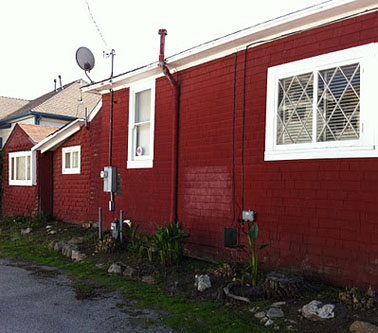 Back in an earlier era, while writing Tortilla Flat Steinbeck was actually living in a family cottage in the City of Pacific Grove, due west of the City of Monterey, on the modest but magical Monterey Peninsula that briefly juts out into the Pacific Ocean. The cottage is still standing – and is still occupied by an ordinary resident, outside the Steinbeck family now. Like other quite enchanted parts of Pacific Grove on the Pacific Ocean, it seems to have avoided the worst of the tourist-trap fate of Monterey. The place nonetheless exudes its own variation on the upscale economic theme. We looked quickly at a meticulously renovated but very small old Pacific Grove cottage, just steps from the ocean, currently offered for sale. It may suit a retired couple that did not need much personal space: the asking price was more than $750,000.
Back in an earlier era, while writing Tortilla Flat Steinbeck was actually living in a family cottage in the City of Pacific Grove, due west of the City of Monterey, on the modest but magical Monterey Peninsula that briefly juts out into the Pacific Ocean. The cottage is still standing – and is still occupied by an ordinary resident, outside the Steinbeck family now. Like other quite enchanted parts of Pacific Grove on the Pacific Ocean, it seems to have avoided the worst of the tourist-trap fate of Monterey. The place nonetheless exudes its own variation on the upscale economic theme. We looked quickly at a meticulously renovated but very small old Pacific Grove cottage, just steps from the ocean, currently offered for sale. It may suit a retired couple that did not need much personal space: the asking price was more than $750,000.
On the very final leg of our journey, from Pacific Grove to Carmel-By-The-Sea, we travelled on a private toll road called 17 Mile Drive. It oozed stupendous affluence even more than Palo Alto – if not any more, say, than the forest Town of Woodside back up north in San Mateo County. The most striking geographical feature of Carmel itself is almost certainly its elegant white sand beaches : undoubtedly the best in California, and perhaps in all of the USA and far beyond.
 The thing that other visitors from Ontario, Canada will tell you about Carmel, apart from its awesome beaches, is that it finally adds up to a grander (and no doubt again more affluent) version of Niagara-on-the-Lake, with a much gentler year-round climate. I was most struck myself by the news that while still mayor of the place in the late 1980s, Clint Eastwood had also made his movie Bird – about the greatest jazz musician who has ever lived (to date at any rate), Charlie Parker – who flew like a bird on the alto saxophone, and once did his own time in California, especially further south in Camarillo.
The thing that other visitors from Ontario, Canada will tell you about Carmel, apart from its awesome beaches, is that it finally adds up to a grander (and no doubt again more affluent) version of Niagara-on-the-Lake, with a much gentler year-round climate. I was most struck myself by the news that while still mayor of the place in the late 1980s, Clint Eastwood had also made his movie Bird – about the greatest jazz musician who has ever lived (to date at any rate), Charlie Parker – who flew like a bird on the alto saxophone, and once did his own time in California, especially further south in Camarillo.
8. The future of Silicon Valley and the future of the USA in the 21st century
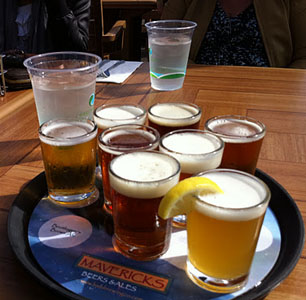 I don’t have much more room for conclusions about our autumn 2011 holiday trip to Silicon Valley, especially if I want to save some space for photographs. And I still don’t really have any big conclusions of my own – beyond the vague symbolism of the two beautiful young East Asian women, taking pictures of the spontaneous mourners outside Steve Jobs’ house, on Waverley Street in Palo Alto.
I don’t have much more room for conclusions about our autumn 2011 holiday trip to Silicon Valley, especially if I want to save some space for photographs. And I still don’t really have any big conclusions of my own – beyond the vague symbolism of the two beautiful young East Asian women, taking pictures of the spontaneous mourners outside Steve Jobs’ house, on Waverley Street in Palo Alto.
On my return to the true north, however, I bumped into two pieces of digital writing, that raise some questions about the economic future of both Silicon Valley and the USA, all present appearances notwithstanding (in either direction). The first is “Silicon Valley can no longer save California – or the US,” by Joel Kotkin, “distinguished Presidential Fellow in Urban Futures at Chapman University in Orange, CA and an adjunct fellow with the Legatum Institute in London.” The second is a review of the new Mike Daisey movie documentary [see March 17, 2012 UPDATE below], The Agony and the Ecstasy of Steve Jobs, by Keith Staskiewicz on the Entertainment Weekly website.
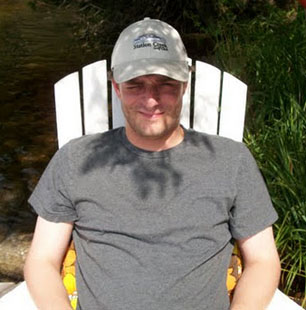 The thrust of the Kotkin piece is that, in an earlier heyday, Silicon Valley was a raging success, because it delivered two different kinds of jobs to the Golden State and America beyond. First here were higher order information technology (IT) jobs, that ultimately invented a wide array of new electronic products with big new markets. Second were a larger number of old-new-style industrial jobs, manufacturing the new products that the IT sector invented.
The thrust of the Kotkin piece is that, in an earlier heyday, Silicon Valley was a raging success, because it delivered two different kinds of jobs to the Golden State and America beyond. First here were higher order information technology (IT) jobs, that ultimately invented a wide array of new electronic products with big new markets. Second were a larger number of old-new-style industrial jobs, manufacturing the new products that the IT sector invented.
Alas, Kotkin urges: in California Steve“Jobs’ death” symbolizes “the end of the state’s high-tech heroic age … Silicon Valley’s [current] job creation numbers are dismal. In 1999 the San Jose-Sunnyvale-Santa Clara area had over 1 million jobs; by 2010 that number shrank by nearly 150,000. Although since 2007 and early 2010 the number of information jobs has increased substantially – up roughly 5000 to a total of 46,000 – the industrial sector, which still employs almost four times as many people as IT, lost around 12,000 … This is partly because Apple, Intel and Hewlett-Packard have shifted their production – which offered jobs to many lower- and medium-skilled Californians – to other states or [especially] overseas … the Valley … increasingly resembles Wall Street – with a few highly skilled employees and well-placed investors making out swimmingly.”
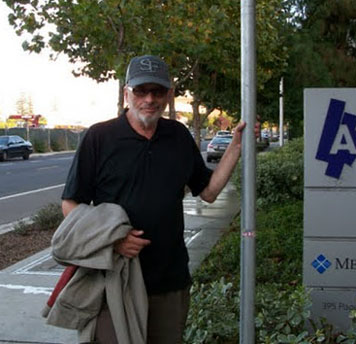 Kotkin goes on: “our future cannot be salvaged by high-tech alone. Many of the country’s greatest assets, for example, are physical; in California these include the best climate for any advanced region in the world, fertile soil, a prime location on the Pacific Rim and potentially huge fossil fuel energy reserves … The green theocracy now in control of Sacramento, however [ie the current vaguely liberal and progressive state government led by Governor Jerry Brown – yet another survivor from the 1960s Age of Aquarius at Haight and Ashbury in San Francisco], has little interest in these aspects of California.”
Kotkin goes on: “our future cannot be salvaged by high-tech alone. Many of the country’s greatest assets, for example, are physical; in California these include the best climate for any advanced region in the world, fertile soil, a prime location on the Pacific Rim and potentially huge fossil fuel energy reserves … The green theocracy now in control of Sacramento, however [ie the current vaguely liberal and progressive state government led by Governor Jerry Brown – yet another survivor from the 1960s Age of Aquarius at Haight and Ashbury in San Francisco], has little interest in these aspects of California.”
I think myself that Joel Kotkin is betraying countervailing theocratic biases of his own in these last comments. The clean energy apostles of Northern California (or even Southern Ontario, for that matter?) may yet bring more good news for economic development than their political and economic opponents of the moment are willing to allow. At the same time, there is some degree of intriguing overlap between Kotkin’s analysis and Keith Staskiewicz’s review of Mike Daisey’s new movie [again see UPDATE below] , The Agony and the Ecstasy of Steve Jobs.
As Staskiewicz explains, Daisey “makes it clear from the start that he is no knee-jerk detractor…Â he has been … a ‘’worshiper at the Church of Apple,’’ since his family purchased an Apple II when he was a child. But an encounter with … photos of the factory in China where the devices are produced and packaged in their antiseptic white boxes, put a chink in his faith … Daisey traveled to the industrial city of Shenzhen and the incomprehensibly enormous plant where many of Apple’s products are assembled by hand by workers as young as 12 years old toiling long hours in poor conditions … He encountered the people who [nowadays] make the gadgets we pretend sprang fully formed from Jobs’ balding head, and his descriptions are full of enough indignation and frustration to hush the audience …”
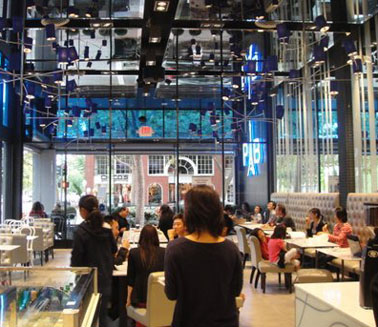 There is food for further thought here, no doubt. Yet in the very end even Joel Kotkin comes to a narrower conclusion very much like the one which does seem to be at the back of my own mind, as I cast a very last glimpse at our autumn 2011 holiday trip to Silicon Valley. It is no doubt true, and important to say, that the long-term future of the USA today “cannot be salvaged by high-tech alone.” Even so, as Kotkin puts it: “The Valley itself will likely do fine. Steve Jobs helped cement” its position “as the epicenter of the high-tech world..” That is also what we seemed to be hearing, as we ate a light breakfast one sunny autumn morning at the elegant new Paris Baguette, on the northwest corner of Waverly and University in the City of Palo Alto, where the average listing price of a house for sale is still more than $2 million.
There is food for further thought here, no doubt. Yet in the very end even Joel Kotkin comes to a narrower conclusion very much like the one which does seem to be at the back of my own mind, as I cast a very last glimpse at our autumn 2011 holiday trip to Silicon Valley. It is no doubt true, and important to say, that the long-term future of the USA today “cannot be salvaged by high-tech alone.” Even so, as Kotkin puts it: “The Valley itself will likely do fine. Steve Jobs helped cement” its position “as the epicenter of the high-tech world..” That is also what we seemed to be hearing, as we ate a light breakfast one sunny autumn morning at the elegant new Paris Baguette, on the northwest corner of Waverly and University in the City of Palo Alto, where the average listing price of a house for sale is still more than $2 million.
UPDATE MARCH 17, 2012: I need to correct one error, and then add some new information, on the remarks above by and about Mike Daisey and his The Agony and the Ecstasy of Steve Jobs.
The error is that this is/was not a “movie documentary” but a live performance at the New York Public Theater by Mr. Daisey, who is “an American monologist – or performer of theatrical monologues.” My apologies. I should have known better, and/or at least read Keith Staskiewicz’s review more carefully!
The new information is that Mike Daisey’s critique of Apple manufacturing operations in China has now been revealed as somewhat “fabulist.” See, eg: “‘This American Life’ Retracts Episode on Apple’s Suppliers in China” ; and “New York Times edits article by Mike Daisey it posted just after Steve Jobs’ death due to fabrications.”
On the other side of the coin there is: “NY Theater Won’t Cancel Show That Inspired ‘This American Life’ Apple Fiasco” ; and Mr. Daisey’s own response on his personal blog: “‘This American Life’ has raised questions about the adaptation of AGONY/ECSTASY we created for their program. Here is my response: … What I do is not journalism. The tools of the theater are not the same as the tools of journalism.”
Theater or journalism, it is, I think, important to know in such a case as this when someone is deliberately exaggerating for dramatic effect. At the same time, the first update link item above does point out that, according to Mr. Daisey’s most persuasive critic, “other people actually had witnessed harsh conditions at the factories that supplied Apple. ‘What makes this a little complicated … is that the things Daisey lied about are things that have actually happened in China’.” And it is perhaps a bit hard not to guess that Apple’s own corporate interests somehow lie at the bottom of Mr. Daisey’s outing, as it were.
None of this, on the other hand, of course excuses my own mistake about the alleged “movie documentary.” And in this case I cannot plead exaggeration for dramatic effect – just an ignorance of the live theater scene in New York. LFB.


Very informative article!!
Nice summary of a very fun trip. It was really great having you guys down here!
I don’t know how much faith I would put in Joel Kotkin’s analysis, as hating on the valley tends to play well in London, NYC and parts of Europe. Joel may prefer to see the state’s abundant natural resources purged for short term economic benefit, with disastrous long term environmental consequences – but the majority of people in California would disagree.
I absolutely enjoy just reading through all your blogs. Just wanted to let you know that you have individuals like me who value your work.